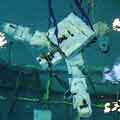A sophisticated machine that can operate in space has just completed trials in a giant pool at the European Astronaut Centre.
The so-called Eurobot has been under development since 2003, with the intention that the multi-jointed, three-armed assistant will eventually handle some of the more mundane tasks currently undertaken by astronauts.
One possible use will be in helping astronauts during extravehicular activity (EVA), more commonly known as spacewalks, but the robot may also be an indispensable helper during human expeditions to the Moon or Mars.
The version of Eurobot used in this week’s exercises is an early prototype called the Weightless Environmental Test (WET) Model, which has been developed for operation in a 'Neutral Buoyancy Facility' – a water tank where the microgravity conditions found in space can be simulated.
Developed for ESA by a consortium led by Thales Alenia Space, the WET Model is similar in size and configuration of the planned Flight Model. It consists of a central ‘body’ structure with three identical arms, each with 7 joints. Although the arms’ length and strength are similar to those of a human, they are much more manoeuvrable and versatile.

In addition, each arm is equipped with a camera and an end-effector which acts as a hand. The WET model has only one type of hand, which is capable of grasping EVA handrails. In contrast, the real Eurobot will have a set of 3 or 4 interchangeable hands. A head camera on a pan and tilt mechanism provides a global monitoring view of the worksite.
In the latest trials, the WET Model was used to verify the operational concept for Eurobot. During tests of its ability to move and manipulate objects, the project team gained hands-on experience of the robot’s capabilities, trying out multi-arm control and coordination, along with visual recognition of obscured targets.
The trials at the European Astronaut Centre (EAC), in Cologne, Germany, conclude the initial verification phase of the Eurobot Wet Model programme, following on from previous preliminary dry and wet tests in Italy.
While the testing of the WET model makes it possible to study the operational aspects of Eurobot, ESA has undertaken a comprehensive programme to further its technological development.
This includes engineering models of the robot arms (called DexArm) and tool exchange device (CTED), the computer vision technology that allows Eurobot to identify and grasp objects (VIMANCO), the central brain that allows coordination of the robot arms’ motion (CONTEXT), a sophisticated human-machine interface that allows tele-operation of the DexArm (Exoskeleton) and a control station that is used to program and control the Eurobot (A-DREAMS).
All of these are being integrated in the Eurobot test bed located at ESA’s Space Research and Technology Centre (ESTEC) in Noordwijk in the Netherlands.




Nanogenerator consumes CO2 to generate electricity
Whoopee, they've solved how to keep a light on but not a lot else.